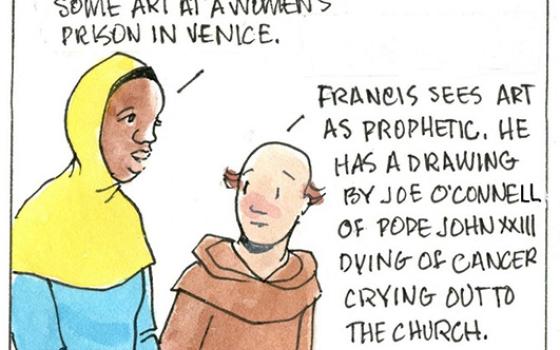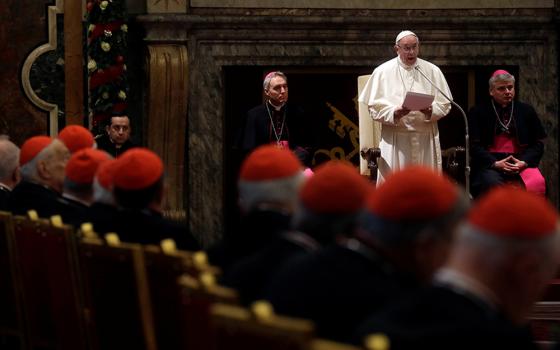As we approach Easter, I think the time is ripe to reclaim for our own lives the earliest articulation of an experience of the Resurrection: that which is noted by Paul.
Rather than another article that rehashes never-resolved arguments about the historicity (and often overly literal interpretation) of the stories as recorded in the four Gospels, especially their Resurrection narratives, I think it best if we recall that probably not all of the Gospels were eyewitness accounts. Their final authors, who wrote the Gospels decades after Jesus' death and attempted to describe the exaltation of Jesus, relied on the stories of other people's experiences in their Resurrection narratives. The unfortunate result of this approach has been an overreliance on a literal interpretation of Jesus' resurrection as a kind of resuscitation of Jesus' body rather than the early disciples' experience of him as risen or alive in their lives through faith and baptism.
Summarizing "the way the four gospel narratives evolved to show the usual signs of the creative presence of later writing, reading, and listening communities" that produced the accounts of the Resurrection, biblical scholar Francis J. Moloney states that only the "fact" of "an empty tomb" can be "subjected to objective historical investigation."
Moloney argues that "there are no documented incidences of the Resurrection from the tomb of a person who was certainly dead" and that "there are no scientifically controllable criteria to judge with absolute certainty what was said to the women" and the others, which is discussed in the various narratives. Instead, he shows that recent biblical scholarship, rather than dwell on such issues (which never can be "proven" from independent sources), stresses the faith of those convinced of their experience of Jesus risen as the Christ in their lives.
Moloney's insights invite us to turn to the earliest written account of the Resurrection. This was not one handed down by others; rather, it is the firsthand account of Paul's own experience of the Risen One.
Paul's experience on his way to Damascus described in Acts (9:3; 22:6; 26:12; 22:14) is articulated less expansively and less explicitly than in his own recollection of the "appearance" (1 Corinthians 9:1). Even in its brevity, his account represents the only eyewitness of Jesus risen as the Christ. He told the story between A.D. 51 and 54, 15 to 20 years before the first Gospel account of the Resurrection. In his first letter to the Corinthians, we read:
I handed on to you as of first importance what I in turn had received: that Christ died for our sins in accordance with the scriptures, that he was buried, and that he was raised on the third day in accordance with the scriptures, and that he appeared (horaō) to Cephas, then to the twelve. Then he appeared (horaō)) to more than five hundred brothers and sisters at one time, most of whom are still alive, though some have died. Then he appeared (horaō)) to James, then to all the apostles. Last of all, as to one untimely born, he appeared (horaō) also to me" (1 Corinthians 15: 1-8).
While he does not state it explicitly, it seems clear that the appearance of the Risen Christ, for Paul, was linked inseparably to his realization ("seeing"?) that those he was persecuting were the living embodiment of Jesus, who also had been persecuted. In 1 Corinthians 9:1, he refers to this experiential appearance ("horaō") as his "seeing" the Christ; and in 1 Corinthians 15:8, it becomes clear that the appearance of the Risen One was, for Paul, the realization that Jesus was now alive in the members of his body, the church.
Jerome Murphy-O'Connor, a Pauline scholar, also links the two references in 1 Corinthians 9:1 and 15:8 as having a very specific meaning. He writes that "1 Corinthians 9:2 ... has very close parallels in Mary Magdalene's experience, 'She saw Jesus' (John 20:14), and announced it to the disciples, 'I have seen the Lord' (John 20:18). They in turn proclaim, 'We have seen the Lord' (John 20:25). The use of the verb 'to see' in immediately post-paschal contexts is well attested."
Paul's "seeing" ("horaō") the Risen Lord came with the realization ("appearance" or "seeing") that those whom he had been persecuting were the living embodiment of the Risen One. "His conversion as a post-paschal apparition is confirmed by 1 Corinthians 15:8 in which he lists himself as the last of those privileged to have seen the Risen Lord," Murphy-O'Connor writes.
If we limit our understanding of the Resurrection to stress the physical "sightings" of Jesus by the early disciples rather than the real, mystical "appearance" or "seeing" noted by Paul, we can easily resort to images of a resuscitated body discovered in different expressions by the early apostles and disciples. But this will get us nowhere because, as Moloney notes, "There is no 'knock-down' objective historical proof for the resurrection events reported in the gospel narratives."
Given this fact, there is another way to approach the Resurrection. Moloney adds: "But there is objective evidence that the earliest church came into existence because of the encounter with the risen Jesus -- whatever that means." If we don't start from the latter insight, we will fail to appreciate that the Gospel narratives represent their authors' best efforts to describe the "appearance" of the Jesus of history experienced by his early followers as the Risen One. This experience transformed their whole being.
Moloney concludes that, while the "modern questions take us nowhere" and "lead to speculations that can either be affirmed or denied," one thing "is certain: the witness of the earliest Church that Jesus 'appeared' is firm. We are not in a situation to describe the physical experience of these encounters, but that they took place should not be question. What took place is hard to determine, but that these encounters took place is affirmed across many traditions."
When we acknowledge that the Gospels reflect the actual Easter event and how it was communicated over the years (first by Mary Magdalene, the Apostles and others who experienced it), we can apply the same process to Paul's final narration of Damascus. His final redaction in 1 Corinthians of "seeing" the Risen One was written almost two decades before the final redaction of the first Gospel (Mark) and decades before the last (John).
I find it fascinating as well as confirming of my thesis that we should begin with the earliest, firsthand account of a Resurrection experience as noted in 1 Corinthians rather than the Gospels. Moloney begins his recording of the Resurrection "appearances" with that of Paul before his lists those in the four Gospels. In his narration, Paul experienced Christ as risen, alive, in each person he was persecuting. Jesus had risen in those believers as the Christ.
I believe this is the key difference from the Gospel narratives. It invites us to retrieve Paul's articulation of his Resurrection experience in theology and the church today and reclaim its basis in mysticism. If we are to articulate this key belief in our faith, we will be more believable to our contemporaries, who are becoming ever-more skeptical of the traditional ways we have articulated our faith, especially when we try to prove what cannot be objectively accomplished.
Returning to Murphy-O'Connor's attestation that Paul was the last on the list "of those privileged to have seen the Risen Lord," it seems to me that, if we understand the scriptural notion of "seeing" as an "appearance" that is more experiential than physical, the list of those now called to "see" Jesus as the Risen Christ includes all the baptized faithful of every age. The Resurrection is not something that happened long ago. As Pope Benedict XVI noted in his 2006 Easter Vigil homily, it happens in each of us "through faith and Baptism."
Building on this insight, it is my conviction that we need to reclaim this Pauline meaning of Resurrection from our futile debates about the meaning of any physical resurrection of Jesus. We also will better be able to respond to avowed atheists like Sam Harris who reject such "religious" arguments but actually believe in the power of religious experiences such as Paul's. Harris calls this "mysticism" in a way that conjures up for me the oft-quoted and favorite saying of Karl Rahner: "The Christian of the future will be a mystic or he will not be a Christian at all."
Paul's Damascus experience was a mystical one. Paul came to "see" the Jesus of history as alive in each and every woman or man that he had persecuted in the house churches of Jerusalem and intended to persecute (if he found them) in the synagogues of Damascus. The basic elements of his mystical experience (which can happen to everyone, including unbelievers), his particular way of "seeing" Christ alive in the members of the body called the "church" is possible for all who believe in this mystical understanding of the body of Christ and who enter into the experience by baptism. Stated in another way, Paul's mystical experience of the Resurrection (his personal experience of faith) led him to become incorporated into the experience by baptism. It was then that the blind man's eyes were truly opened. He could now no longer live as once he had; now he was in Christ, Christ was in him and this "Christ" in him included all the baptized members of the body of the Risen One.
Playing into the challenges of atheists like Harris has also led us to fail to make the proper link between the two key concepts of logos and mythos as developed in the insights of a historian of religion like Karen Armstrong (independent of any historical critical or narrative approach to the gospels). For Armstrong, logos is what is observable or empirical; it is the realm of science. On the other hand, mythos represents that which cannot be proven but is believable. Both logos and mythos are true; however, while mythos cannot be "seen" or proven scientifically, "seeing" will be believable because it reveals the realm of faith. The problem with religion, both Armstrong and Harris contend, occurs when those in religion try to "prove" what is unprovable. They try to make faith a fact by identifying mythos as logos. Probably nowhere do we find the occurring as when we take the mythos of the Gospel narratives and make them logos. On the contrary, when we base ourselves in Paul's account of his own mystical experience of Jesus as risen-in-the-members-of-his-body-called-church, we enter into a whole new understanding of resurrection that takes us beyond logos or mythos: This is the realm of religious experience.
In probing the meaning of the Resurrection, it's important to realize that, along with trying to address the way the crucified Jesus was glorified, the early Gospel writers were trying to describe the repeated, shared experience of those convinced that something happened to them. This event was called Jesus' resurrection.
This understanding invites us to return to the earliest articulation of the resurrected Christ that preceded all the Gospel accounts: Paul's reference to his experience of the Resurrected one that he put on par with those accounts, which would be later narrative in the Gospels and Acts. However, unlike those experiences, Paul's "seeing" the Risen Lord was not linked to any physical form as we find in the Gospel narratives and in Acts; it was in the form of a mystical experience of the Crucified One being crucified anew in the believing Christians.
I sincerely believe that the Pauline account of his Resurrection experience will do much to move the church into the kind of mystical future envisioned by Rahner. It will also honor the mythos of the Gospel writers who tried to describe the experience of Jesus being "seen" by Cephas, Mary Magdalene, James and the 500 in a way that is more believable.
With the other well-known theoretical atheists, Harris rejects the "god" of religions, especially Islam, Roman Catholicism and Mormonism. However, unlike his peers, he argues that history has shown "a certain range of human experience [that] can be appropriately described as 'spiritual' or 'mystical' -- experiences of meaningfulness, selflessness, and heightened emotion that surpass our narrow identities as 'selves' and escape our current understanding of mind and brain." He argues:
For millennia, contemplatives have known that ordinary people can divest themselves of the feeling that they call "I" and thereby relinquish the sense that they are separate from the rest of the universe. This phenomenon, which has been reported by practitioners in many spiritual traditions, is supported by a wealth of evidence -- neuroscientific, philosophical, and introspective. Such experiences are 'spiritual' or 'mystical," for want of better words, in that they are relatively rare (unnecessarily so), significant (in that they uncover genuine facts about the world) and personally transformative. They also reveal a far deeper connection between us and the rest of the universe that is suggested by the ordinary confines of our subjectivity.
Harris' insights help me recognize the futility of arguments about the Resurrection as though it were something that happened to Jesus apart from what happened to those who "saw" it or "experienced" it (or will continue to do so in disciples today). Thus my conviction that moving from a concentration on the Gospel narratives stressing the "bodily" resurrection to a reclamation of the mystical experience of the Risen Christ will help us grasp the heart of the mystery of faith in the Resurrection which, indeed, is the heart of our belief.
Saul was transformed by his mystical experience of the Risen Christ. He insisted that his Resurrection experience was equal to those in the Gospels who had their own experiences of "seeing" Jesus as alive in, among and around them. This led the convert Paul to become the missionary theologian of the church's understanding of itself as the extension in time and space of the Jesus of history. Now this Jesus was alive ("risen") in each and every member of the living body of Christ, in the church and throughout the cosmos.
This approach, I believe, will move us closer to the kind of mysticism or spirituality that Harris envisions as authentic. He writes:
There is no doubt that experiences of this sort are worth seeking, just as there is no doubt that the popular religious ideas that have grown up around them, especially in the West, are as dangerous as they are incredible. A truly rational approach to this dimension of our lives would allow us to explore the heights of our subjectivity with an open mind, while shedding the provincialism and dogmatism of our religious traditions in favor of free and rigorous inquiry.
In his 2006 Easter Vigil homily, Benedict declared that the Resurrection "ushered in a new dimension of being, a new dimension of life in which, in a transformed way, matter too was integrated and through which a new world emerges." Such imagery shows the necessity of Easter people of every age to continue our own work of transformation that we might be or become those who, in Christ, usher in a new created order that transcends all forms of human separation (2 Corinthians 5:15-17). In this way, we ourselves will be resurrected, becoming a new creation that reflects the essence and lived-reality of the Resurrection as revealed in Paul's account and in Benedict's remarks.
There will continue to evolve in the world, beginning with us, "a new dimension of being, a new dimension of life in which, in a transformed way, matter" too will be "integrated and through which a new world emerges." When we allow the Resurrection to "reach" and "seize" us in this way, the Christ and the new creation will be the best Easter present we, as Paul noted in his 1 Corinthian letter, will not only "receive" but can "hand on."
[Capuchin Franciscan Fr. Michael H. Crosby is the author of many books, including Spirituality of the Beatitudes: Matthew's Vision for the Church in an Unjust World.]







